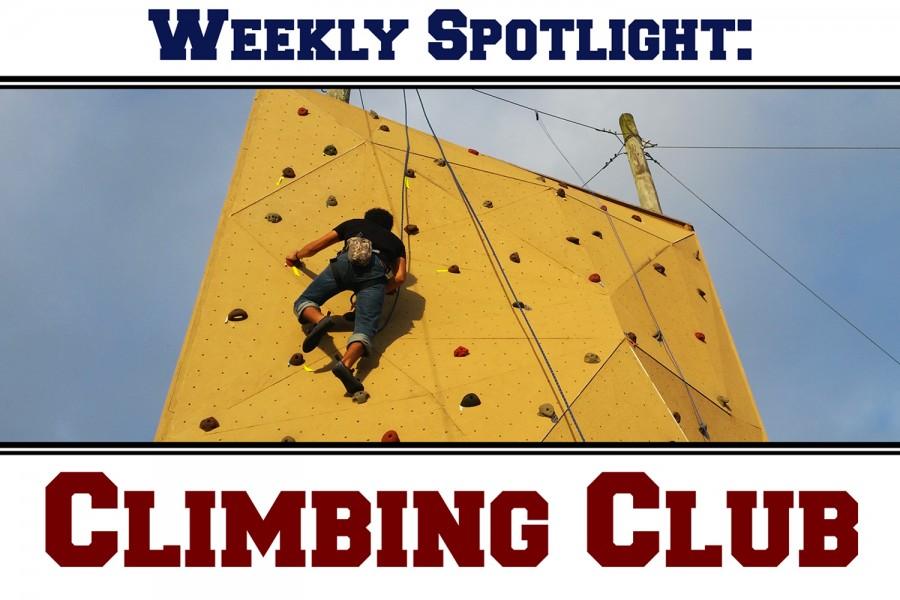Weekly Spotlight: Climbing Club
Check out Climbing Club, FAU’s own club dedicated to reaching new heights.
Club president Daniel Valladares climbing the 30-foot rock wall at the climbing course. Photo by Brittany Ferrendi | Features Editor
February 11, 2016
Welcome to the Weekly Spotlight, where you can grab all the important info about on-campus organizations in one easy place.
This week we spoke with Daniel Valladares, president of the Climbing Club at FAU, and Youkendy Mera, risk management officer. We caught up with Valladares just as he was finishing climbing the 30-foot wall at the climbing course with Mera as his belayer — a climbing partner that uses rope and harnesses to ensure the safety of the climber.
UP: According to the collegiate website, Climbing Club participates in competitions. Could you tell us more about that?
DV: Competitions start in this spring semester, and competitions depend on the gym that we go to. Some gyms have just bouldering [walls], some have more. The last competition we did was [Friday, Jan. 29], it was just bouldering. Bouldering is the kind of sport that is ground level. It involves more problem-solving skills, so even if it’s ground level … it still needs endurance and power.
On Feb. 13, we have another competition in Jacksonville. So far, we have at least 14 people that are going. The competition is really good because it’s a lot of fun; because everyone can do them, even if you’re just a beginner you can just go and have fun for the competition. They have grades for every level.
UP: How often are the competitions?
DV: It really depends. This year there are four gyms that are making competitions, but last year we only had three. So the climbing gyms have to decide whether they are going to have the competition or not, and that varies between years.
UP: How many schools compete?
DV: A bunch of schools compete, about maybe 10 schools. All of the schools from Florida that have climbing clubs, and even people from Georgia, North Carolina and Tennessee come here to compete.
UP: Climbing Club began in 2005. What came first, the climbing wall or Climbing Club?
YM: I’d have to go with the climbing wall. [The ropes course] has been open since 2002.
UP: You mentioned the bouldering wall. What other types of climbing walls does your club have?
DV: The top-roping wall. It’s called that because the ropes are already set at the top [of the 30-foot wall]. The bouldering walls are not more than 15 feet. And we also have the climbing shack: That’s literally a bouldering wall that is just in a u-shape, which is exclusively just for Climbing Club members.
UP: There’s also a large set-up over at the course that looks like a bunch of trapezes. What is that?
DV: This is called the ropes course. This is just for groups like them [he gestures to a group of eight people standing in a circle], they are a leadership class. So, in order to bring forth their leadership skills, they do different exercises here that involve guidelines and rules and team preparations for them. That’s separate [from Climbing Club].
UP: What would you say is the most difficult wall to climb?
DV: I would say the bouldering wall is very hard because it is inclined, so it is [angled] 30 degrees [inwards]. Part of the wall is easy, but the other side is harder. For the bouldering wall, you just need a lot of power, which I would say is the hardest part.
UP: When I tried the shack wall, it was very difficult and everyone told me to do the 30-foot rock wall instead, which looked a lot more intimidating.
DV: It took me a whole year to go just all the way around the shack, and eventually I got so good at it that I would start doing that blindfolded. So, that was fun because that helps you a lot on focusing your body position when you climb.
UP: What can you tell me about belaying?
DV: Belaying is the most important safety part of climbing, because you really need to trust your belayer and you really need to see how he belays first before climbing the wall. I teach people how to belay, and I just climb 10 feet and then drop myself to see how they react. Some people, depending on if you’re big or small, come out flying because my weight is higher, and they come flying straight to the wall and they get scared, and let go of the rope and then you fall. So, you really need to know how they are going to react to a fall and how they manage being on pressure.
UP: How many belayers do you have? And how many members?
DV: So far, everyone from Climbing Club belays except the newbies. We have about 25 to 30 members, from which 20 are really into it. They show up almost all the time. The others are people that have been climbing before from the [previous] years of climbing club and they show up once in awhile.
UP: What advice would you give to students that are interested in becoming a part of climbing club?
DV: My advice would be to just come and try it, because you never know how good you are at the sport, and climbing is more about being persistent. So I believe that the hardest part is not just climbing, the hardest part is coming back after that first day of trying it, because you realize that it’s a hard sport, it takes a lot of power, and at the beginning you are really not going to be so good at it. The hardest part is to come back and keep trying, it’s perseverance.
If you’re someone that likes to achieve goals and have daily goals, and challenge yourself even more — like I climb the feats blindfolded — then this is your place.
UP: What’s something about Climbing Club that the average student wouldn’t be able to guess?
DV: Most people think that because you’re afraid of heights, that you wouldn’t be able to do climbing. But actually I believe it helps a lot with some people that are afraid of heights, because we have people that tell me they are afraid of heights and then they climb all the way up to the top, come back down and just keep going. The rope keeps you safe, the belayer keeps you safe.
UP: When and where do you meet?
DV: We meet here, at the ropes course … Mondays and Fridays, 5 p.m. to 7 p.m. Two hours, but since we have more members we are trying to expand our hours, because not everyone gets to climb all the time, there are lines of people that want to climb, especially the new people.
Sometimes we decide that we are not going to climb at the school, that we are going to climb at the rock-climbing gym in Fort Lauderdale. So we meet at the parking garage in front of the rec center and carpool.
UP: Is there a joining fee?
DV: We have a joining fee of $25. That includes equipment like harnesses, belay device, ropes and we also do climbing trips to climb outdoors, so that’s also on your fee. Once per semester.
UP: What do you need to bring to Climbing Club for the first time?
DV: For the first time you need to bring your Student I.D., comfortable clothing and closed-toed shoes. If you wear sandals here then you won’t be able to climb.
UP: Is there anything else that you would like prospective members to know?
DV: I just want them to know that climbing club is growing a lot faster, and we more than tripled our members from last year. We’ve been doing trips, and we just got a new climbing wall, everything here is new. We’re just getting the shack remodeled, so that’s going to be the new thing for next year.
Brittany Ferrendi is a staff writer for the University Press. If you would like to contact her regarding this or other articles, email her at [email protected].
















